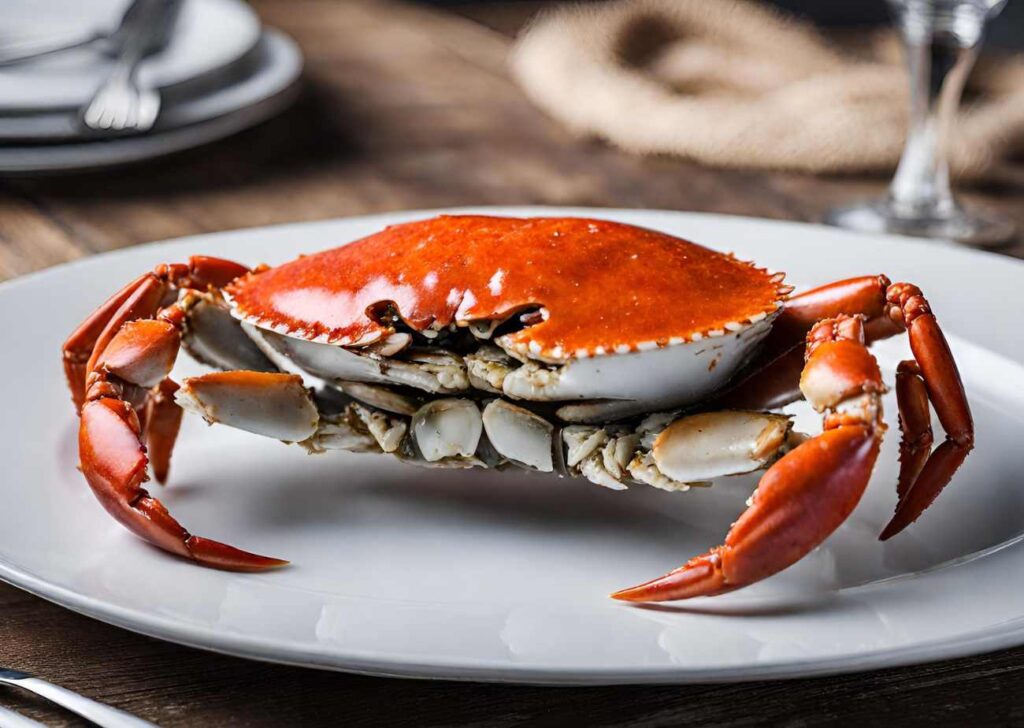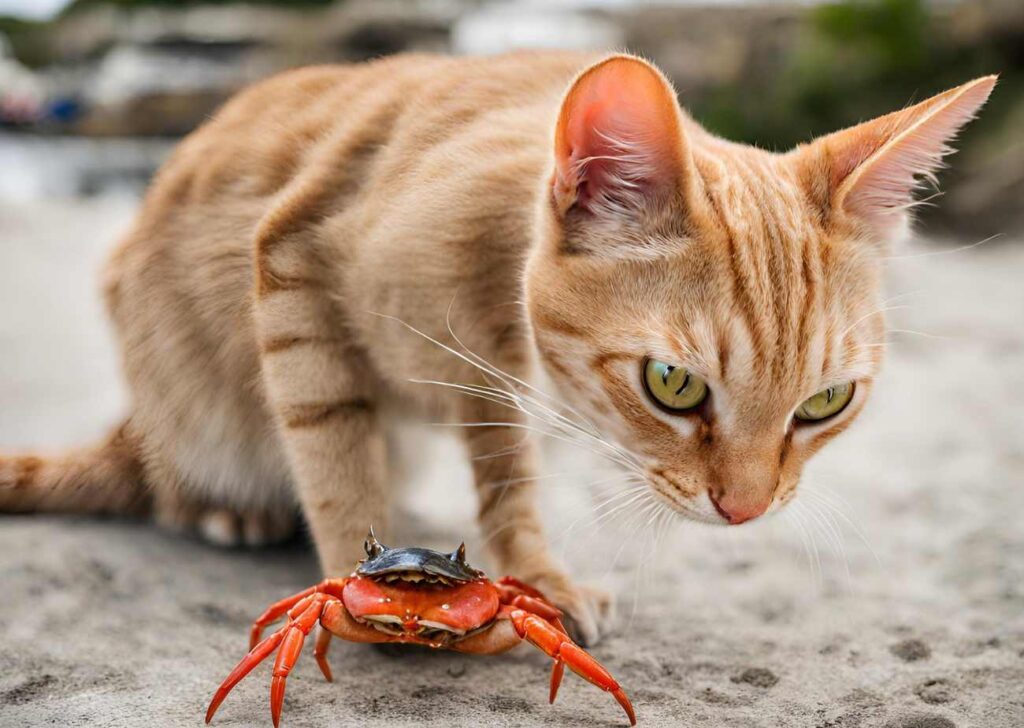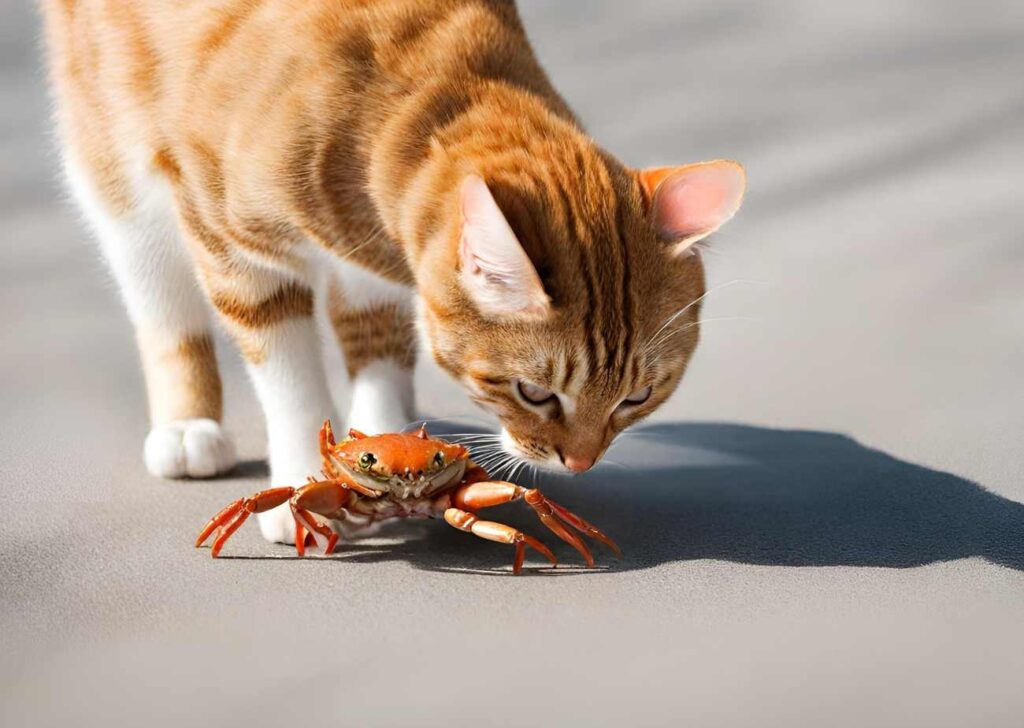Welcome to Eatdemy, your eating academy.
The curiosity of a cat is a well-known trait, one that leads them to explore, play, and often taste everything that piques their interest. Among the array of things that grab their attention, food items, especially seafood, often top the list.
However, as cat owners, the responsibility of distinguishing between what’s safe and what’s not for our feline friends falls upon us. A common query that emerges from the love cats have for seafood is, “Can cats eat crab?”
Key Takeaways:
- Cats have a penchant for seafood, including crab.
- Crab meat can be a source of essential nutrients for cats when given in moderation.
- It’s crucial to understand the nutritional benefits and potential risks associated with feeding crab to cats.

Can Cats Eat Crab? The Very Short Answer
The short answer is yes, cats can enjoy a small portion of crab now and then. However, the long answer involves a deeper understanding of feline dietary requirements, potential health benefits, and risks associated with crab consumption.
Cats are known for their love for fish, but their palette often extends to other seafood items like crab. The aromatic allure of seafood can be irresistible to most cats, making crab a potential treat to offer.
Nutritional Benefits of Crab for Cats
Feeding your cat the same food every day can get monotonous, not just for you but for your furry friend as well. Introducing a variety of foods can not only bring a change but also add different nutrients to your cat’s diet. One such food item that holds nutritional value is crab. But what exactly does crab meat offer to your cat?
Key Takeaways:
- Crab meat is rich in protein, which is vital for your cat’s muscle growth and overall development.
- Omega-3 fatty acids in crab contribute to a healthy skin and coat for your cat.
- Essential vitamins and minerals found in crab can be beneficial for various aspects of your cat’s health.
Protein Content and Its Importance for Cats
Protein is a critical component of every cat’s diet. It plays a fundamental role in muscle development, bone health, and the overall growth of your cat.
The Role of Protein
- Muscle Maintenance: Protein helps in maintaining muscle mass and strength, which is crucial for your cat’s agility and overall physical health.
- Body Repair and Growth: It aids in repairing body tissues and fosters growth, ensuring your cat stays healthy as it ages.

Omega-3 Fatty Acids and Their Benefits
Omega-3 fatty acids are another essential nutrient found in crab meat. These fatty acids are known for their multiple health benefits.
Benefits of Omega-3 Fatty Acids
- Skin and Coat Health: Omega-3 fatty acids help in keeping your cat’s skin healthy and their coat shiny.
- Anti-inflammatory Properties: They possess anti-inflammatory properties that can help in reducing inflammation and promoting joint health.
Vitamins and Minerals in Crab Meat
Crab meat also hosts a variety of vitamins and minerals that can be beneficial for your cat.
Notable Vitamins and Minerals
- Vitamin B12: Essential for many bodily functions including brain function and the production of red blood cells.
- Zinc: Important for immune system support and wound healing.
- Phosphorus: Crucial for bone health and energy production.

Table: Nutritional Content of Crab Meat
| Nutrient | Amount per 100g | Benefits for Cats |
|---|---|---|
| Protein | 20g | Muscle maintenance, growth |
| Omega-3 fatty acids | 1g | Skin and coat health, anti-inflammatory |
| Vitamin B12 | 9 µg | Brain function, red blood cell production |
| Zinc | 6.5 mg | Immune support, wound healing |
| Phosphorus | 405 mg | Bone health, energy production |
Potential Risks and Adverse Reactions
Imagine setting a plate of delicious crab meat down for your cat, only to watch them experience discomfort or worse, a choking episode. While crab can be a nutritious treat, like every other food, it carries its share of risks.
Key Takeaways:
- Awareness of the allergies and physical risks associated with crab is crucial for your cat’s safety.
- Choking hazards are a significant concern that demands attention.
- Knowledge of common adverse reactions helps in prompt identification and action.
Allergies and Symptoms
Just as in humans, cats can be allergic to certain food items, and seafood like crab is no exception.
Identifying Allergies
- Itchy Skin: Cats may exhibit itchy skin or develop rashes.
- Digestive Upset: Vomiting or diarrhea are common signs of a food allergy.
- Respiratory Issues: In rare cases, allergies might lead to respiratory issues such as coughing or wheezing.
Managing Allergies
- Vet Consultation: If you suspect an allergy, consult a veterinarian for proper guidance and treatment.
- Dietary Adjustment: Based on vet advice, modifying your cat’s diet to exclude the allergen is crucial.

Choking Hazards and Other Physical Risks
The physical form of crab meat can present hazards. The shells, in particular, are a cause for concern.
Choking Concerns
- Crab Shells: Hard and sharp, crab shells can cause choking or injure the internal lining of your cat’s digestive tract.
- Size of Meat Pieces: Offering crab meat in large chunks can also pose a choking hazard.
Prevention Measures
- Proper Preparation: Remove all shells and offer crab meat in small, manageable pieces.
- Supervised Feeding: Always supervise your cat while they’re enjoying crab to quickly address any choking incidents.
Table: Common Adverse Reactions
| Adverse Reaction | Symptoms | Management |
|---|---|---|
| Allergic Reaction | Itching, vomiting, diarrhea | Consult a veterinarian, dietary adjustment |
| Choking | Coughing, distress | Remove choking hazard, vet consultation if necessary |
| Digestive Upset | Vomiting, diarrhea | Dietary adjustment, vet consultation |
Preparing Crab for Cats
The aroma of cooked crab can be an olfactory carnival for your cat, beckoning them to take a bite. However, as a responsible cat parent, ensuring that crab is prepared safely is crucial to transform this seafood delicacy into a safe, enjoyable treat for your feline friend.
Key Takeaways:
- Proper cooking is vital to kill any harmful pathogens in crab meat.
- Avoid seasonings, oils, and crab shells to prevent any adverse reactions.
- Portion control is key to ensure crab remains a treat, not a meal substitute.
Cooking Guidelines to Kill Harmful Pathogens
Cooking crab meat thoroughly is the first step towards making it a safe treat for your cat.
The Importance of Cooking
- Killing Pathogens: Cooking crab meat helps in killing harmful bacteria and parasites that can cause illness.
- Easier Digestion: Cooked crab meat is easier for cats to digest compared to raw crab.
Cooking Tips
- Boiling or Steaming: These are the best methods to ensure crab meat is cooked thoroughly.
- Avoiding Undercooking: Make sure the crab meat is fully cooked to avoid any health risks.
What to Avoid: Seasonings, Oils, and Crab Shells
What you add to the crab meat or fail to remove from it can turn a tasty treat into a health hazard.
Avoiding Additives
- Seasonings: Common seasonings like salt, garlic, and onion are toxic to cats.
- Oils: Avoid cooking crab meat with any kind of oil as it can upset your cat’s stomach.
Handling Crab Shells
- Removal: Make sure to remove all crab shells as they can cause choking or digestive blockages.

Portion Control and Frequency of Feeding Crab to Cats
Crab meat should be an occasional treat rather than a staple in your cat’s diet.
Maintaining Balance
- Not a Meal Substitute: Crab meat should not replace the balanced diet your cat requires.
- Frequency: Offering crab once a week or less is a safe approach to maintain dietary balance.
Portion Guidelines
- Small Portions: Offer crab meat in small portions to prevent overeating and to maintain a balanced diet.
Table: Guidelines for Preparing and Feeding Crab to Cats
| Aspect | Guidelines |
|---|---|
| Cooking Method | Boiling or steaming to kill harmful pathogens |
| Additives to Avoid | Seasonings, oils |
| Handling Shells | Remove all crab shells |
| Portion Size | Small portions as an occasional treat |
| Frequency | Once a week or less to maintain a balanced diet |
Commercial Cat Foods with Crab Ingredients
Crab is not only a gourmet delight in many human cuisines, but it also finds its way into the world of feline dining through commercial cat foods.
Overview of Commercial Cat Foods with Crab
The market offers a variety of commercial cat foods with crab ingredients, catering to the seafood aficionados among the feline population.
Variety and Brands
- Wet Cat Food: Brands like Fancy Feast and Sheba have lines of wet cat food with crab flavors.
- Dry Cat Food: Although less common, some brands offer dry cat food with a hint of crab.
Ingredient Combinations
- Seafood Medley: Often, crab is combined with other seafood like tuna or shrimp for a richer flavor profile.
Benefits and Considerations
Embracing commercial cat foods with crab ingredients can be a delightful change for your cat, but it’s essential to weigh the benefits against any considerations.
Benefits
- Nutritional Boost: Crab ingredients add a source of protein and omega-3 fatty acids to the cat food.
- Flavor Variety: Introduces a new flavor to your cat, potentially making mealtime more exciting.
Considerations
- Allergy Potential: Some cats might have seafood allergies, and introducing crab might trigger allergic reactions.
- Quality of Ingredients: Not all crab-infused cat foods are created equal. The quality of crab and other ingredients vary across brands.
Table: Benefits and Considerations of Crab-Infused Cat Food
| Aspect | Details |
|---|---|
| Nutritional Boost | Source of protein and omega-3 fatty acids |
| Flavor Variety | New taste experience for your cat |
| Allergy Potential | Risk of allergic reactions to seafood ingredients |
| Quality of Ingredients | Varies across brands, important for overall nutrition |

Alternatives to Feeding Raw or Cooked Crab
While the decadent texture and oceanic flavor of crab can be a delightful treat for your cat, there are other seafood wonders and alternatives that can equally tickle their taste buds.
Crab Sticks and Imitation Crab: What to Know
Imitation crab and crab sticks might seem like a convenient alternative to real crab, but what lies beneath the surface?
What are They?
- Imitation Crab: It’s a type of seafood made from starch and finely pulverized white fish, shaped and cured to resemble crab meat.
- Crab Sticks: These are essentially the same as imitation crab but shaped into sticks.
Nutritional Value
- Protein: They offer protein but not as much as real crab.
- Additives: Often contain additives and artificial flavoring that can be harmful to cats.
Verdict
- Not Recommended: Due to the additives and lack of real crab meat, it’s best to avoid feeding imitation crab or crab sticks to cats.
Other Seafood Options for Cats
There’s an ocean of seafood choices that can provide a healthy and enjoyable dining experience for your cat.
Fish Varieties
- Salmon: Rich in Omega-3 fatty acids, but should be cooked thoroughly to kill parasites.
- Tuna: Can be a tasty treat but should be given in moderation due to mercury content.
Shellfish Options
- Shrimp: Cooked shrimp can be a healthy, protein-rich treat.
- Mussels: Cooked mussels can also be a good source of protein and Omega-3 fatty acids.
Safety Precautions
- Proper Cooking: All seafood should be cooked properly to eliminate the risk of parasites and bacteria.
- Moderation: Seafood should be offered in moderation to prevent any dietary imbalances.
Table: Seafood Alternatives and Their Nutritional Value
| Seafood Option | Nutritional Benefits | Considerations |
|---|---|---|
| Salmon | Rich in Omega-3 fatty acids | Ensure thorough cooking to kill parasites |
| Tuna | Good source of protein | Moderate feeding due to mercury content |
| Shrimp | High in protein | Offer cooked to eliminate bacterial risk |
| Mussels | Provides protein and Omega-3s | Offer cooked and in moderation |
FAQs: Can Cats Eat Crab or Shrimp?
The oceanic flavors of crab and shrimp can indeed be a part of your cat’s culinary adventure, but with certain precautions.
Crab for Cats
- Cooking: Ensure the crab is cooked thoroughly to eliminate any harmful pathogens.
- Portion Control: Crab should be offered as a treat, not a meal replacement.
- Shell Removal: Make sure to remove all crab shells to prevent choking or digestive blockages.
Shrimp for Cats
- Cooking: Like crab, shrimp should also be cooked properly before offering it to your cat.
- Portion Size: Small portions are advisable to maintain a balanced diet.
What Seafoods Can Cats Eat?
The seafood spectrum is vast, but not all are suitable for feline consumption.
Suitable Seafood
- Fish: Varieties like salmon and tuna can be offered in moderation.
- Shellfish: Besides crab and shrimp, cooked mussels can also be a safe choice.
Precautions
- Cooking: All seafood should be cooked to kill any potential parasites or bacteria.
- Moderation: Seafood should be an occasional treat to prevent dietary imbalances.
Can Dogs and Cats Eat Crab Meat?
Sharing the crab feast with dogs and cats can be a joyful experience, but requires a cautious approach.
For Cats
- Yes: Cats can eat crab meat when cooked properly and offered in moderation.
For Dogs
- Yes, with Caution: Dogs can also enjoy crab meat but ensure it’s cooked, and observe for any allergic reactions.
General Precautions
- Cooking: Thorough cooking is crucial to eliminate any health risks associated with raw seafood.
- No Seasonings: Avoid any seasonings, oils, or additives which can be harmful to both cats and dogs.



